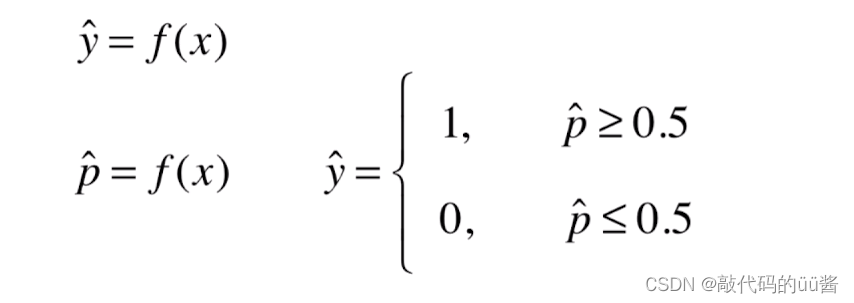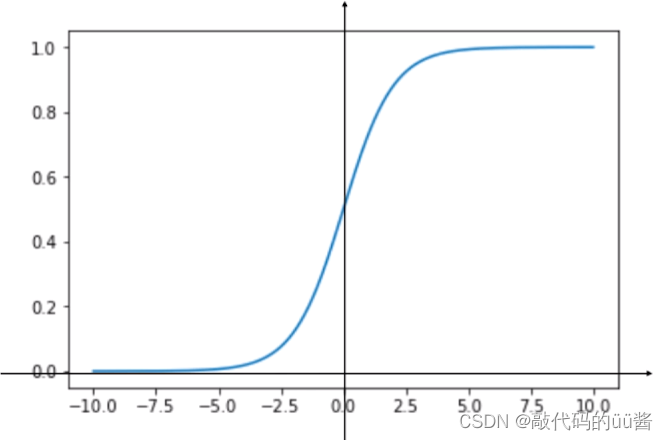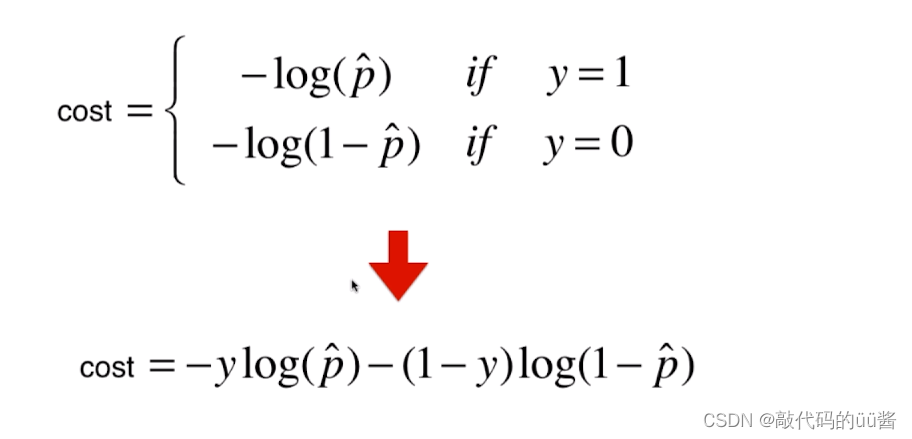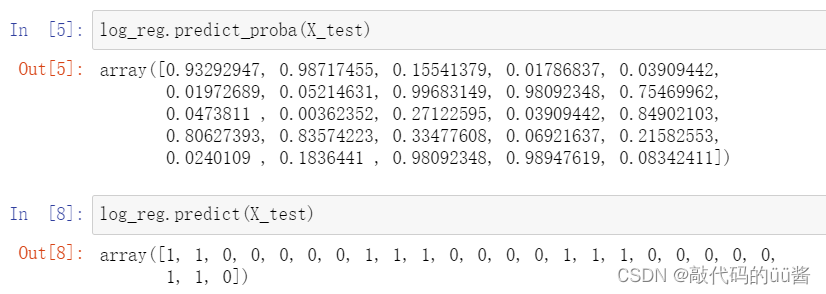目录
一、什么是逻辑回归
逻辑回归主要解决分类问题,通常只可以解决二分类问题。实际上逻辑回归的原理是将样本的特征和样本发生的概率联系起来,由于概率是一个数,因此也可以叫做一个回归算法。

在这里,引入一个函数Sigmoid,它的公式如下:
值域为(0,1)
- 当 t > 0 时,p > 0.5
- 当 t < 0 时,p < 0.5

因此,概率估计值求解公式转换为
基于此,对于给定的样本数据集X,y,我们如何找到参数theta,使得用这样的方式可以最大程度获得样本数据集X对应的分类输出y?
二、逻辑回顾的损失函数
根据该公式定义一个损失函数,如果给定一个样本,当
- y = 1,p越小,cost越大
- y = 0,p越大,cost越大

基于此,对于逻辑回归,m个样本的损失函数可以定义为:

该损失函数没有公式解,只能使用梯度下降法求解。
三、实现逻辑回归算法
1、自定义一个LogisticRegression 类
代码示例:
import numpy as np
from sklearn.metrics import accuracy_score
class LogisticRegression:
def __int__(self):
''' 初始化Logistic Regression模型'''
self.coef_ = None
self.interception_ = None
self._theta = None
def _sigmoid(self,t):
return 1. / (1. + np.exp(-t))
def fit(self,X_train,y_train,eta=0.01,n_iters=1e4):
''' 根据训练数据集X_train,y_train,使用梯度下降法训练Logistic Regression模型'''
assert X_train.shape[0] == y_train.shape[0], \
"the size of X_train must be equal to the size of y_train"
# 逻辑回顾损失函数实现
def J(theta, X_b, y):
y_hat = self._sigmoid(X_b.dot(theta))
try:
return - np.sum(y*np.log(y_hat) + (1-y)*np.log(1-y_hat)) / len(y)
except:
return float('inf')
# 逻辑回归求梯度
def dJ(theta, x_b, y):
return x_b.T.dot(self._sigmoid(x_b.dot(theta)) - y) / len(x_b)
def gradient_descent(x_b, y, initial_theta, eta, n_iters=1e4, epsilon=1e-8):
theta = initial_theta
i_iter = 0
while i_iter < n_iters:
gradient = dJ(theta, x_b, y)
last_theta = theta
theta = theta - eta * gradient
if (abs(J(theta, x_b, y) - J(last_theta, x_b, y)) < epsilon):
break
i_iter += 1
return theta
x_b = np.hstack([np.ones((len(X_train), 1)), X_train])
initial_theta = np.zeros(x_b.shape[1])
self._theta = gradient_descent(x_b,y_train,initial_theta,eta,n_iters)
self.interception_ = self._theta[0] # 截距
self.coef_ = self._theta[1:] # 斜率
return self
def predict_proba(self,X_predict):
""" 给定待预测数据集X_predicr,返回表示X_predict的结果概率向量"""
assert self.interception_ is not None and self.coef_ is not None, \
"must fit before predict!"
assert X_predict.shape[1] == len(self.coef_), \
"the feature number of X_predict must be equal to X_train"
X_b = np.hstack([np.ones((len(X_predict), 1)), X_predict])
return self._sigmoid(X_b.dot(self._theta))
def predict(self,X_predict):
""" 给定待预测数据集X_predicr,返回表示X_predict的结果向量"""
assert self.interception_ is not None and self.coef_ is not None, \
"must fit before predict!"
assert X_predict.shape[1] == len(self.coef_), \
"the feature number of X_predict must be equal to X_train"
proba = self.predict_proba(X_predict) #概率
return np.array(proba >= 0.5,dtype='int') #强制将返回的布尔转换成数值0和1,代表两个不同的类别
def score(self,X_test,y_test):
""" 根据测试数据集 X_test 和 y_test 确定当前模型的准确度 """
y_predict = self.predict(X_test)
return accuracy_score(y_test,y_predict)
def __repr__(self):
return "LogisticRegression()"2、测试
代码示例:
import numpy as np
import matplotlib.pyplot as plt
from sklearn import datasets
iris = datasets.load_iris()
X = iris.data
y = iris.target
X = X[y<2, :2] #对于X的每一行选取y=0和y=1的行
y = y[y<2]
from sklearn.model_selection import train_test_split
X_train,X_test,y_train,y_test = train_test_split(X,y,random_state = 666)
from mySklearn.LogisticRegression import LogisticRegression
log_reg = LogisticRegression()
log_reg.fit(X_train,y_train)
log_reg.score(X_test,y_test)
log_reg.predict_proba(X_test)运行结果:

数组中的每一个元素都有相应的一个概率值,概率值越趋近于1,模型就更愿意将这个样本分类为1,越趋近于0,则将样本分类为0。





















 7万+
7万+











 被折叠的 条评论
为什么被折叠?
被折叠的 条评论
为什么被折叠?








